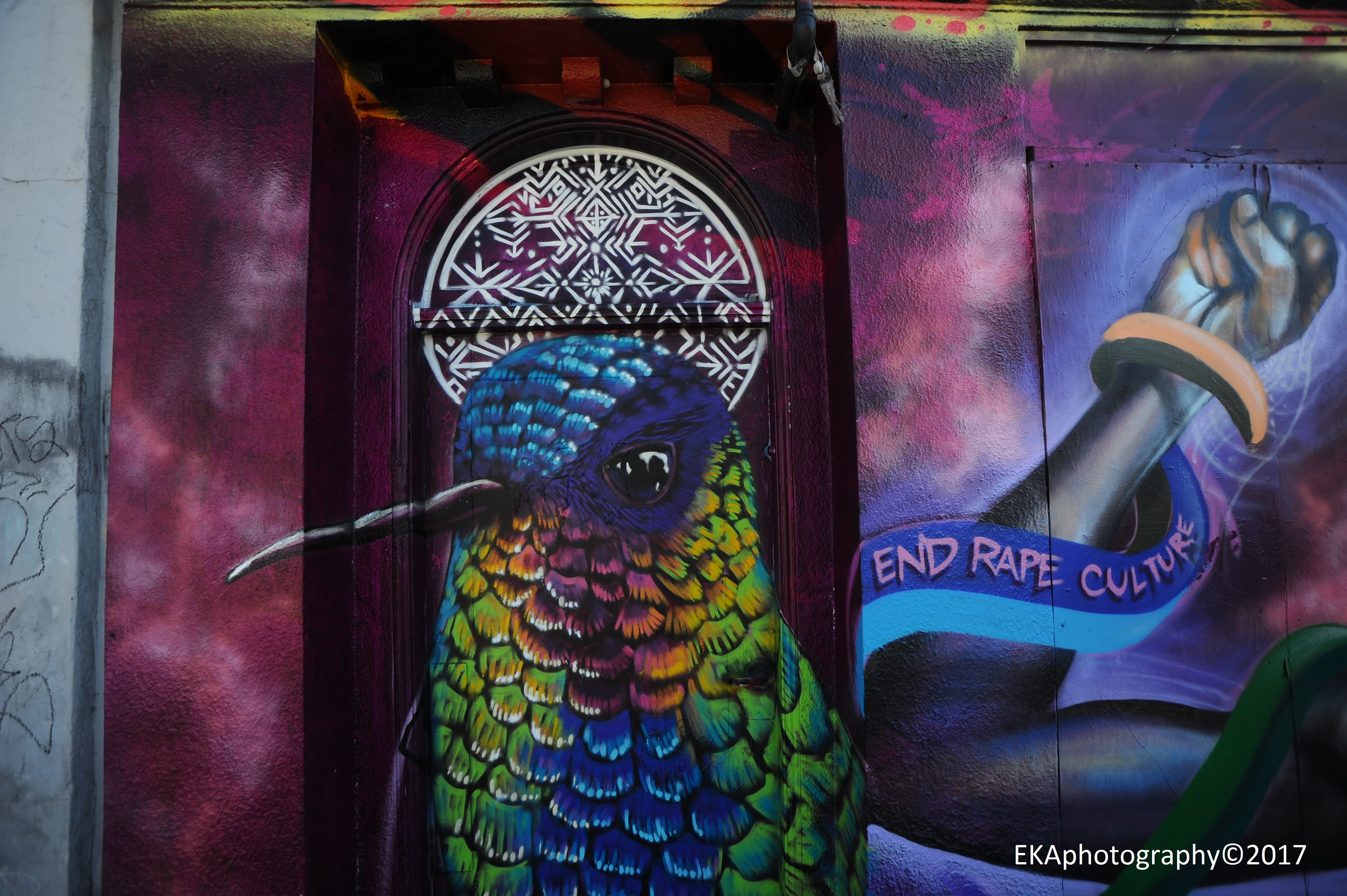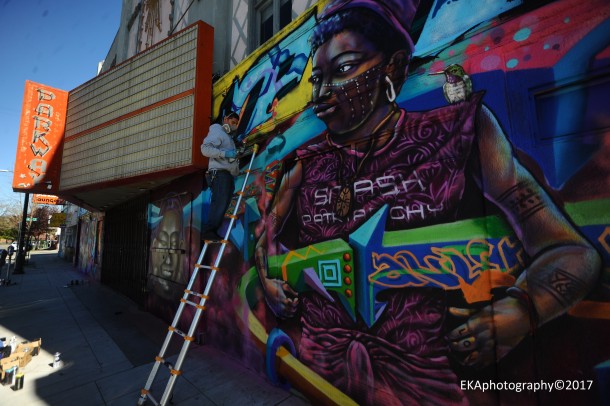
A CRP guest artist repainting the Parkway Theater
Recently, the Community Rejuvenation Project (CRP) addressed Oakland’s controversial public art ordinance, analyzing the implications of a since-withdrawn staff report (a copy is here) outlining proposed changes, as well as some background on the history of the ordinance itself.
While the staff report’s small changes to clarify language and buttress the ordinance against lawsuits seemed reasonable, the tacked-on proposal to incentivize the in-lieu contribution is both both problematic and unnecessary. CRP has since gotten word that the item has been pulled, for the second time, from the CED agenda, and that CM McElhaney’s office is reportedly drafting another alternate proposal, which may surface as early as the March 28 Community & Economic Development (CED) meeting.
In the meantime, CRP received another analysis and summary of the staff report, which draws many of the same conclusions as we did. The analysis was authored by a well-known Oakland-based public artist, who wished not to be identified. Let’s just say that the author is well-versed not only in the intricacies of creating public art, but also in navigating bureaucracy, and demystifying the machinations of city staff.
“The staff recommendations are based on a false or manufactured concern that there are not going to be funds going into the in-lieu account, even though there is NO evidence for this.”
The response starts with a general summary: “The most significant proposed change is that it directs the vast sums of expected public art funds away from public art commissioned directly from artists by the developers into a city fund that can pay the costs, including staff salaries, of city initiated projects that have not yet been defined. What is particularly egregious is that this will be achieved by significantly reducing the total amount of money that is intended for public art.” (Emphasis added.)
The response goes on to speculate about the motivation for the incentivizing of the in-lieu fee, noting that “there were no in-lieu funds flowing into the city,” more than two years after the ordinance was passed.” However, the author argues that “that is not because all the developers have decided to purchase artworks for their projects. It is because the Building Dept. has not been enforcing section 15.70.090 of the ordinance that requires the decision to purchase artworks or pay the in-lieu fee at the time of issuing the building permit.”
Indeed, only one onsite Public Art In Private Development project has even been reviewed by the Public Art Advisory Committee, as of March 2017. That being the case, it’s difficult to follow the city’s logic for incentivizing the in-lieu contribution, since many developers might have chosen that option, were the city enforcing its own code requirements.
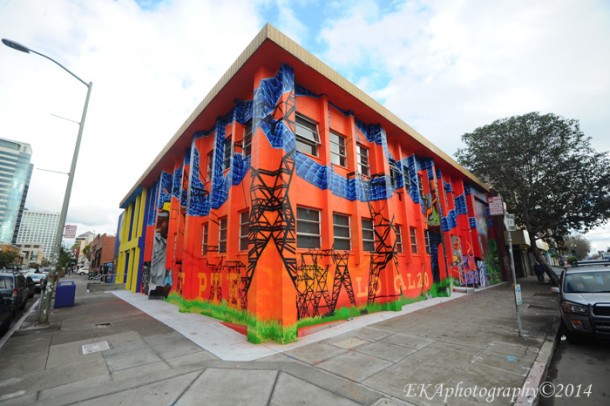
Local 20 building, Old Oakland
One department head blamed the lack of code enforcement on the still-unresolved lawsuit, but that’s still a justification of inserting a self-serving additional proposal into a staff report. Perhaps the city should have taken the concerns of advocates and its own public art advisers more seriously in 2014, and come up with a more-comprehensive, lawsuit-proof ordinance in the first place. But we digress.
Let’s return to the response: “The staff recommendations are based on a false or manufactured concern that there are not going to be funds going into the in-lieu account, even though there is NO evidence for this. Many people familiar with the dynamics of public art knew that many of the developers would adopt to pay the in-lieu fees instead of purchasing art for their projects…So now staff is proposing to amend the ordinance to induce, not just permit, developers to pay their public art requirement directly to the city, rather than purchasing public artworks for their projects. Why the rush now? Why not wait and see how the program is working before trying to divert all or most of the public art funds to the city?”
Those questions seem valid, especially given that one of the primary objectives of Oakland’s public art program is to encourage collaborations between artists and developers. Well, guess what? By incentivizing the in-lieu contribution, the city would be de-incentivizing onsite projects, which appears to represent the opposite of that objective.
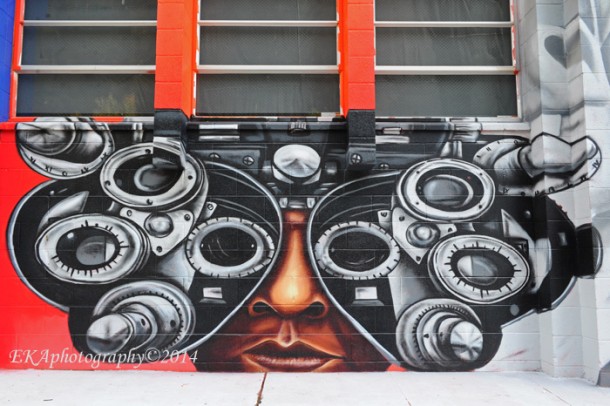
detail from Local 20 building
The response continues: “Business practices will mean than many, if not most, of the projects will be forced to give the money to the city instead of creating public art. Fiduciary Responsibility requirements of most partnerships and most lenders will require the developers to minimize their costs and therefore donate the 80% of the fees to the city rather than creating public art.”
Why is a 20% reduction in fees problematic? Because it would, in effect, leave a significant amount of money on the table. How much money? According to the response, “There is easily $5 billion of new development coming to Oakland in the foreseeable future. If we imagine a mix of 60% commercial and 40% residential, that will mean $40 million in public art fees. The proposed amendment would mean that there is $8 million LESS for public art. How can this be in the interest of the city?”
If sightseeing opportunities are a goal of the public art program, wouldn’t it make sense to maximize those opportunities in downtown — easily the city’s most active retail, entertainment, and commercial district?
A good question, indeed. And here’s where the city needs to come clean about the apparent discrepancy between its stated program goals and objectives for public art, and what appears to be an old-fashioned money grab. Are the city’s interests and the public’s interests one and the same? No. Is everything the city does in the best interest of the residents of Oakland? Hardly.
It is true that the Public Art Advisory Committee (PAAC) greenlights public art projects through a bureaucratic, semi-public process. But the Public Art Fund, which the PAAC oversees, isn’t just used for public art- it can also be used for administrative costs and things which have nothing to do with the commissioning of new public artworks. While there is an argument that incentivizing the in-lieu contribution could conceivably result in more equitable distribution of public art projects throughout the city, any such result would be arbitrary, and not mandated, since there is no specific language in the ordinance or the PAAC by-laws which mentions equity or prioritize funding of projects in underserved districts.
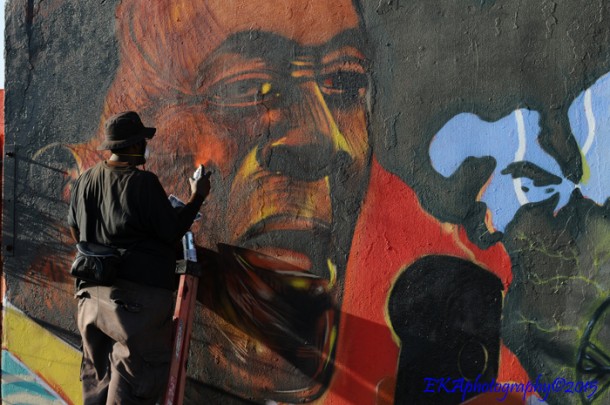
Kasso painting a portrait of Kwame Nkrumah, Afrikatown, West Oakland
The response goes on to unpack the components of the staff report, noting that the current ordinance states, “The purpose is to promote the arts in the City of Oakland by requiring the inclusion of a public artwork in new development projects in Oakland.”
Incentivizing the in-lieu contribution, therefore, would be much more than the “minor” change the city states—it would completely shift the purpose of the ordinance away from new development.
The response finds that “city staff have drafted an amendment that can only have the effect of creating less public artworks. In their own words, they are recommending a change that will reduce the total money that can be spent on public art, and in particular incentivizes developers to NOT create public artworks in their developments. This directly contravenes the intent and purpose of the original ordinance.”
It’s difficult to argue with this logic. Less money is less money, no matter how much spin one puts on it. Again, there is an argument that less overall artwork might be a worthy trade-off for public art projects which serve under-served communities or directly mitigate the detrimental aspects of development, but that argument cannot be made honestly without stipulating equitable criteria and a process for equitable allocation. Which makes it facetious, until such time as the ordinance’s language is amended to allow for this directive.

One side of the “Woman Power” mural
The response goes on to note a few additional instances of the staff report’s contradictions. Despite being couched in flowery language, it’s hard to reconcile the fact that reducing the overall amount of public art funding does not uphold the stated purpose of “financially support[ing] local artists and attract[ing] tourism by creating a sense of place and more sightseeing opportunities.” It’s also unclear how the commissioning of onsite public art under the current ordinance would somehow fail to do these things.
If sightseeing opportunities are a goal of the program, wouldn’t it make sense to maximize those opportunities in downtown — easily the city’s most active retail, entertainment, and commercial district? Tourists are routinely advised to avoid parts of West and East Oakland, and to make those areas a destination would require economic investment on a far greater scale than what public art funds can provide. It’s unclear who would think a sightseeing tour of Eastmont Mall is going to attract many takers. Moreover, any renovation of that structure will generate additional public art funds which could be used for onsite art.
Clearly, the staff report has not outlined a clear rationale for its proposed incentivization of the in-lieu contribution. That’s an understatement; if anything, it completely contradicts the intent of the current ordinance and creates what could be reasonably viewed as a city “slush fund,” as one concerned artist noted at a January meeting convened by city staff.
We’ll have to wait and see what McElhaney’s office comes up with, as their proposed alternative to the proposed alternative. But in the meantime, here are a few suggestions:
- ·Why not incentivize public-private partnerships and the spirit of collaboration, by offering developers who work with community groups to produce art a 5% reduction in fees?
- Further incentivization, say, another 5%, could be provided by meeting equity criteria, which could be easily adapted from that used to score applicants to the Cultural Art Fund — and vetted with the Department of Race and Equity.
- Don’t incentivize the Public Art Fee at all, but allow for cultural easements for projects which meet community and equity criteria.
Why consider these options? Incentivizing onsite projects according to the above guidelines would encourage collaborative efforts while giving community stakeholders direct input and creating an opportunity for developers to be good guys. That would be a win-win and would generate goodwill moving forward. The overall amount of public art would still be reduced, but by a smaller amount which may represent a fair trade-off for community input and including equity-specific language. Furthermore, viewing the public art process, or any city process, through an equity lens, is a step in a positive direction.
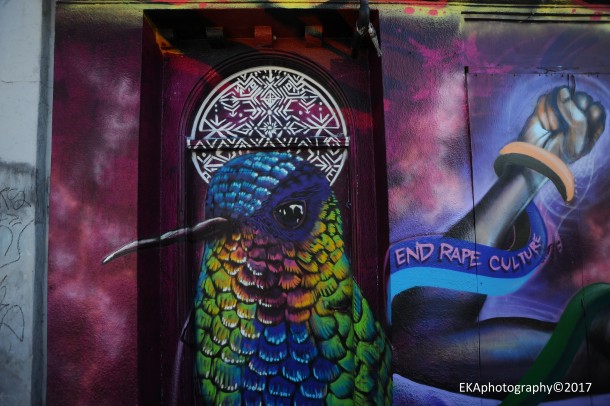
Detail from “Woman Power”
As for the in-lieu contribution, it doesn’t make fiscal or rational sense to incentivize it, in effect making it another tax mandated by the city which can be used to line the city’s own coffers instead of supporting local artists financially. While many artist advocacy groups have pointed out the Cultural Arts Dept. is underfunded and understaffed, there are other ways to increase investment in arts without sabotaging the objectives of the city’s public art program. All of them require heavy lifting and, perhaps, clear and rational thinking, but city staff should welcome those challenges.

